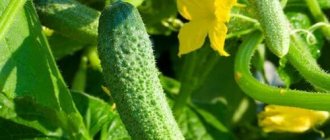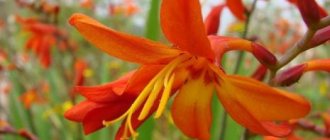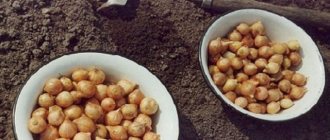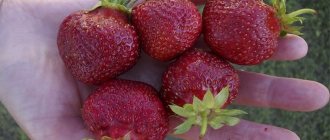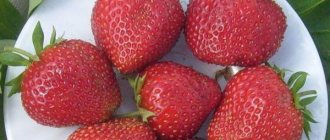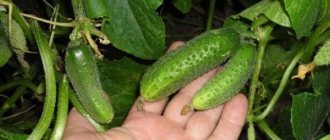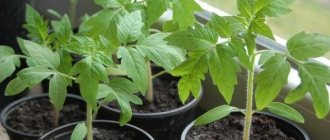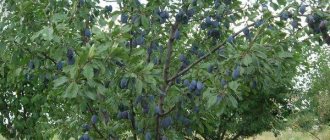The Em champion variety, which breeders presented to farmers back in 1982, is not only highly productive. He's special. Large-fruited, perfectly fruiting in any region, disease-resistant and with ultra-class fruits.
| Height | Landing location | Ripening time | Fruit color | Fruit size | Origin | Fruit shape |
| Medium height | Greenhouse, Open ground | Mid-season | Reds | Large | Variety | Flat-round |
Description and characteristics of the variety
Tomato Em is a champion that has been tested by time and hundreds of thousands of gardeners. Reliable and stable.
Part of the group of determinants, compact and easy to care for.
Characteristics of bushes:
- shoot height 60-65 cm;
- trunks are sparsely leafy, neat;
- leaves are ordinary, medium in size;
- the first bunch is formed after 5-7 leaves;
- all subsequent ones through 2 sheets;
- There are only 6-7 tomatoes on the bunches.
Ripening dates and growing regions
The yield of the harvest begins in the middle period. After 112-124 days, the first giants are removed from the shoots.
The variety is included in the Siberian collection. This means that the plants are maximally adapted to the difficult climate of Siberia, the Urals, and the Far East. Cultivation is carried out in all regions of the country:
- in the north under shelters with the possibility of heating;
- in temperate and southern regions in open beds, and, if necessary, in the first month with replanting under film.
Reviews
According to reviews from amateur vegetable growers, the variety confirms almost all the positive characteristics stated by the authors: it is very productive, resistant to late blight, and has a good taste.
Vegetarian Angelina from Rybinsk notes that these tomatoes can grow with a characteristic bandage in the middle of the fruit (it is clear that such tomatoes are not included in advertising photos for bags of seeds).
Em Champion has earned its popularity among summer residents: although it is not completely universal and has a noticeable drawback (storage problems), its advantages clearly outweigh this drawback. Weighty, tasty, heart-shaped tomatoes will certainly please the gardener who grew them and will make him want to continue working with this variety of tomatoes.
Features of cultivation and storage
Seedlings are planted when the seedlings are 50-55 days old.
It is advisable that the predecessors in the garden be carrots, beet, lettuce or green manure.
In order for the variety to lead and achieve maximum productivity, simple conditions are observed:
- They are planted sparingly - no more than 3 bushes per 1 m2.
- Complex fertilizers are applied regularly - at least 2 times a month.
- Water infused with shells and bio-infusions are used for irrigation.
- Mulch with a layer of 7-10 cm.
Advantages and disadvantages
- Among the main advantages of the variety:
- short stature and weak branching (which allows it to be grown in urban conditions on the balcony);
- resistance to temperature changes;
- the ability to grow both in open and protected ground;
- high productivity;
- balance of acids and sugars in the pulp;
- versatility in application;
- resistance to fungal diseases.
Among the disadvantages of "Em Champion" is its low shelf life. The fruits do not tolerate transportation over long distances, so they are not stored.
Worldview of cultivation
It is recommended to sow seeds in March. The sowing container must have drainage holes. The soil should first be disinfected. To do this, pour boiling water or a solution of phytosporin over it. This action will help destroy dangerous viruses and get rid of pests. The seeds need to be soaked in a weak solution of potassium permanganate for half an hour, then dried and ready for sowing.
Seeds are planted to a depth of 2-3 cm. There is no need to coat the crops, just spray with water and cover with polyethylene or film on top. Before emergence, the boxes should be kept in a room at a temperature of +23-+25 degrees. As soon as loops of sprouts appear on the surface, the cover is removed.
Diving is carried out at the stage of appearance of 1-2 leaves. The seed is planted in a separate container. Approximately 10-14 days before planting in the ground, the seedlings undergo hardening. To do this, the seedlings are taken outside every day, increasing the residence time. If tomatoes are grown in a greenhouse, planting is carried out in May; for open ground, planting is carried out in early July. There should be a distance of 50 cm between the seedlings and a row spacing of 70 cm.
Features of care
The procedures for caring for tomatoes are standard, as for all garden crops: soil care, watering and fertilizing. As necessary, the crop is pinched, removing excess shoots.
Watering and fertilizers
Watering is carried out with clean and warm water, ideally rainwater collected in barrels. Tap water must be left standing to get rid of harmful impurities. You can use subsurface irrigation or furrow irrigation.
The frequency of procedures is adjusted as the top layer of soil dries, by about 10-15 cm. You should not allow it to dry out too much: because of this, the fruits may subsequently crack. "Em Champion" should not be overfed, especially with nitrogen fertilizers.
The variety needs 4 feedings per season:
- the first - 2 weeks after disembarkation. For 10 liters of water, dilute 15 g of ammonium nitrate, 40 g of superphosphate, 30 g of potassium chloride;
- the second - during the formation of buds. To 10 liters of water add 30 g of superphosphate, 15 g of potassium sulfate, 5 g of boric acid;
- the third - after flowering. Use diammofoska 40 g/10 l of water;
- the latter is in the active fruiting phase. 30 g of superphosphate are diluted per 10 liters of water.
After watering, be sure to loosen the top layer of soil. This should be done carefully and not deeply, so as not to damage the roots of the seedlings. It is enough to go to a depth of 8-10 cm, and the crust on the soil, which prevents the access of air, will be broken.
It is equally important to weed out weeds. Weeds usually have a deep and branched root system, which allows them to draw out nutrients and moisture for their own development, drowning out cultivated plants.
As mentioned above, the standard variety stops its growth on its own, practically does not branch, and therefore does not require formation. The exception is growing on a balcony in a limited space; here it is advisable to form one shoot.
Stepchildren need to be removed in open ground; in greenhouse conditions, only the lower leaves are removed. Pinching begins after the formation of the flower cluster. The lower leaves of the plant are removed when the bush reaches a height of 20 cm.
Important! Pruning of the bush is carried out exclusively in the morning in dry weather in order to speed up the healing of the cuts and avoid infection with fungal diseases.
There are usually no problems with growing Em Champion; it is resistant to diseases and pests. However, with some errors in care or unfavorable weather conditions, the development of diseases and insect invasion is possible.
Main diseases and pests and methods of combating them:
- Black spotting - the biological preparation “Gamair” is used for treatment. Plants are watered with a solution of 1 tablet per 5 liters of water. Repeat procedure in a week.
- Top rot - for medicinal watering, one 2 ml ampoule is diluted in 2 liters of water.
- Phytophthora - the biological preparation “Alirin-B” is used. The working solution for irrigation is prepared in the proportion of 2 tablets per 10 liters of water, repeated treatment after 5 days.
- Codling moth, sawfly - a broad-spectrum acaricidal drug "Agravertin" is used against insects. Treatment is carried out by spraying in cloudy but not humid weather. The working solution is prepared in a proportion of 2 ml per 1 liter of water.
- White butterfly - the drug "Arrivo", a solution of 1.5 ml/10 l of water, is effective against the pest. Treatment is carried out by spraying.
Basic preventive measures against diseases and pests:
- compliance with crop rotation;
- cleaning the area before planting;
- processing of planting material, soil for seedlings and containers for sowing;
- timely fertilizing and compliance with watering standards;
- soil care.
Em Champion tomatoes are easy to care for, but you still need to devote time to them. Despite the fact that the bushes of this variety have a short trunk, they need to be tied up. It is also worth making supports for the branches so that they do not break under the weight of the fruit.
Proper care. Supports or tying
If the tomato is growing in unprotected soil, there is no need to pinch the top or remove the fruit clusters. It is also necessary to water in a timely manner, get rid of weeds and loosen the soil. Complex fertilizers are suitable for this variety as a top dressing.
Note! Champion tomatoes come in several types. There are varieties with similar names: Champion tomato, M 14 Pink Champion tomatoes, and you can even hear the non-existent name of the Ex Champion tomato.
They should not be confused, for example, from the characteristics and descriptions of the Champion tomato variety, you can understand that these tomatoes are hybrids. They cannot be propagated from seeds obtained independently. The appearance and structure of Champion fruits differ from those of Em Champion.
Em Champion is easy to care for and resistant to diseases. They are easy to grow and harvest an excellent tasty and healthy harvest, but it is not profitable for farmers to grow plants with quickly perishable fruits. This variety is great for the vegetable garden, garden or cottage.
Caring for tomatoes in open ground
Watering
Tomatoes prefer high soil moisture near the roots up to 85% and air humidity up to 60%. It is necessary to ensure regular watering every 3–5 days, up to 5 liters of water per bush. During fruiting, reduce the amount of watering to once every 5–7 days. Water in the morning or evening at the root. Use water pH 6–6.5, heated to +16–18 °C.
If you water more often, the fruits will not be sugary. Excessive watering will increase the humidity in tomato plantings and promote the appearance of fungal diseases. With irregular watering, the fruits will begin to crack. A sign of insufficient watering is that the leaves wither and the buds fall off. A lack of moisture will lead to poor fruiting, the fruits will become small and will not correspond to the varietal characteristics.
When deciding to grow tomatoes every year, it is advisable to purchase a hygrometer - a device for determining air humidity.
Feeding with fertilizers
Why do tomatoes need macro- and microelements:
- activate growth, flowering and fruiting;
- reduce the number of barren flowers;
- improve the synthesis of proteins, carbohydrates and vitamins in fruits;
- the plant becomes resistant to changes in air temperature and gets sick less.
What fertilizers to use:
- During the period of seedling growth, choose fertilizers with nitrogen for the growth of green mass. Use ammonium nitrate and urea once every 2–3 weeks.
- During flowering and fruit formation, use potassium-phosphorus preparations every three weeks. It is recommended to use potassium monophosphate, diammophos.
- Spray plants to add trace elements of boron, zinc, magnesium, and calcium. Preparations such as “Boric acid” and “Reacom for tomatoes” promote pollination and fruit growth and increase yield.
Formation of a bush - pinching
The plant develops shoots on the sides of the main stem - stepsons, from which extra stems grow. It is recommended to remove these shoots and pinch out the top growth point of the bush in July.
Why stepchildren:
- accelerate the growth of tomatoes and increase yield;
- direct the nutrients accumulated by the seedling to the growth and ripening of fruits;
- avoid dense plantings when there is a risk of spreading fungal diseases.
How to stepchild:
- start pinching 20 days after planting the seedlings in the ground;
- once every 5–8 days, pluck no more than two to three shoots at a time from one bush;
- do not allow shoots to grow excessively; if they are 4–7 cm long, remove them;
- leave a “stump” of half a centimeter; it will not allow a new shoot to appear quickly;
- use disinfected pruners or scissors;
- work during the daytime, during which time the wound at the cut site will quickly dry out.
Bush formation options:
Bushes of tall varieties of tomatoes form one stem. Such plants form flower clusters up to the very top of the shoot, so you can remove all lateral shoots without reducing the yield.
Medium-sized varieties grow in two stems. One of the most powerful sprouts is left on the bush, and the rest are removed.
Low-growing varieties are grown in three stems. The two best side shoots are left on the bush.
How to tie tomatoes
Tall bushes with long shoots and short bushes with large fruits need a garter.
Why tie it:
- watering at the root is simplified, water does not fall on the fruit;
- tomatoes from the lower shoots are eaten by slugs and earthworms;
- the bush is better ventilated, the effectiveness of fungicides and insecticides increases;
- convenient to harvest without damaging the plant.
Do not use thin wire or fishing line. Use special reusable straps, which are sold in specialized stores. This material will last for many years. It is recommended to disinfect it every year before use.
Garter methods:
- A peg near each bush. It can be plastic, bamboo, wood.
- Trellis. Powerful stakes made of metal or wood are dug into the ground at a distance of several meters from each other. A wire is stretched across them at a distance of 30 cm.
- Hooks with fishing line. A method in which a rope is pulled over stakes. A fishing line with a plastic hook at the end is attached to this cable at a distance of 30 cm, to which the shoots of the plant are attached.
- Plastic arcs are dug in near each bush. The shoots are secured with garters in several places.
Diseases and pests: control methods and prevention
Despite the high resistance of the crop to diseases of the nightshade family, tomato is still susceptible to bacterial black spot and blossom end rot. These are fungal diseases, the pathogens of which successfully reproduce at high humidity and air temperature.
Prevention against them includes monitoring moisture in the beds, timely loosening the soil and removing weeds with roots. For treatment, use a calcium nitrate solution by spraying diseased plants. The drug “Fitolavin” helps against bacterial spotting.
To protect the crop from attacks by insect pests (whiteflies, mole crickets, slugs, cutworms), plants are sprayed with infusions of fragrant herbs once a week. It is also good to plant sharp-smelling herbs next to tomatoes.
Crushed cloves of garlic and fish heads buried in the beds help against pests. The Colorado potato beetle and slugs are collected by hand, and the soap solution used to treat the stems saves from aphids.
Among the industrial insecticides, the preparations “Zubr” and “Lepidotsid” are used. But do not forget that chemical treatment is possible only until the first ovaries.
Reference. Tomatoes grown on balconies, as a rule, do not get sick and are not attacked by parasitic insects.
